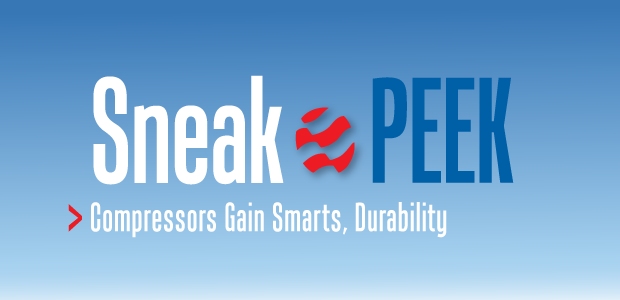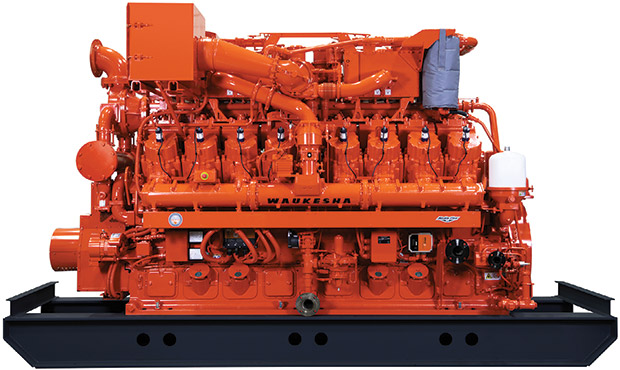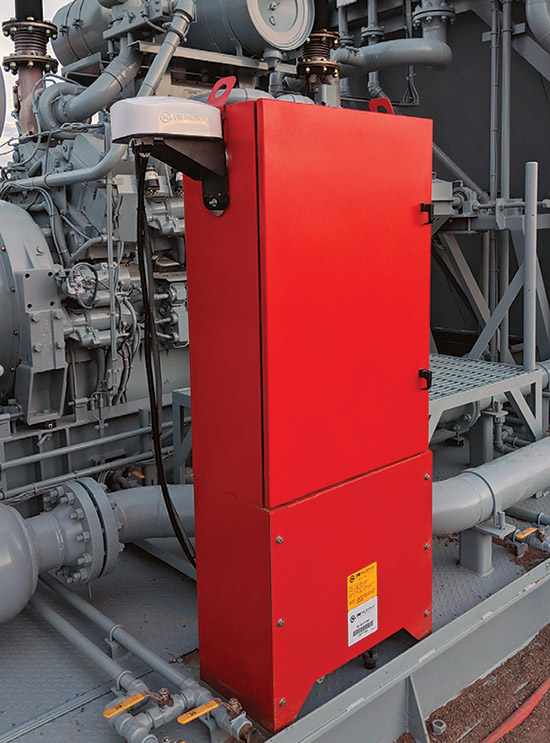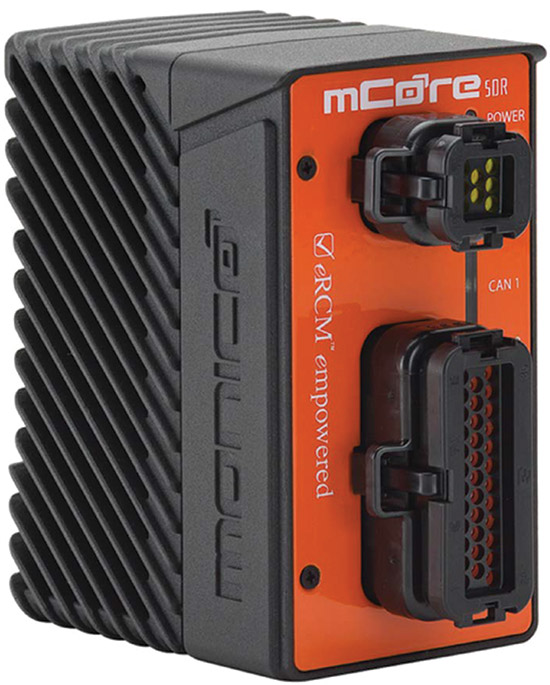
Production & Processing
Compressors Gain Smarts, Durability
By Colter Cookson
The level of ingenuity needed to improve gas compression packages used to boost multiphase and dry gas from the wellhead to gas gathering points, and on to processing points and compressor stations in today’s challenging market, only heightens the need for compression reliability as well as flexibility.
Compression packages must contend with ever-changing operating conditions and nearly constant dust, heat, moisture and other elements that have a knack for disrupting performance. The engines driving these packages must compensate for these variations while adhering to strict emission limits.
Increasingly sophisticated automation is helping compressors adjust to infinitesimal environmental changes, but it is only one of the innovations deployed to push compressor performance to new heights. Others include a powerful lubricant that extends equipment life and engines that pack more power into a small footprint.
“There always will be customer demand for engines to deliver more power and reliability at a lower cost,” observes Ryan Krafcheck, senior product manager at INNIO Waukesha. “We could get more power by pushing the engine harder, but that may hurt its reliability. Instead, we are finding ways to increase power output without placing more stress on key components.”
Krafcheck summarizes that approach as creating engines that “work smarter, not harder.” He says it explains the success of the Waukesha VHP Series Five, an engine family that simultaneously boosts power 13% while slicing 18%-20% off operating costs. “We were able to turn up the power output without increasing temperatures and pressures on the piston or cylinder head by changing to the Miller combustion cycle, which shifts work from the piston to the turbocharger,” he says.
“The engines also use an improved cylinder head design that reduces the temperature in the key exhaust valve stem region as much as 40% by bringing the cooling passage farther down along the guide,” he adds. “This improves the reliability of the head and nearly eliminates exhaust valve sticking.”
The engines only require oil and spark plug changes every 4,000 hours, Krafcheck says, noting that the spark plugs are made from affordable materials. “We could have achieved 4,000-hour spark plug life with plugs made from precious metals, but those would cost the operator significantly more. By optimizing how and when the plug fires, we were able to extend the same benefit while actually reducing cost to the user,” he says.
The series includes 1,500, 1,900, and 2,500 horsepower models. All three share a control system and components such as spark plugs, oil filters, cylinder heads and liners, Krafcheck mentions. “This simplifies customers’ parts inventories and means technicians who know how to work on one engine can handle the other two,” he explains.
Meeting Fleet Needs
As capital constraints encourage operators to rent compressors rather than buying their own, rental fleets are showing more interest in high-horsepower models, Krafcheck reports. He attributes some of that to advances in engine and compressor design.
“It usually is less expensive to buy and operate a single high-horsepower unit than it is to pair two lower-horsepower units, but there is a trade-off between power and mobility,” he says. “Because of its power density and compatibility with compact compressor frames such as Ariel’s new KBK, the 2,500 horsepower 9394GSI S5 is light and portable enough to meet fleets’ needs.”
Through creative engineering, INNIO Waukesha is introducing engines that deliver more power than their predecessors without increasing wear on critical components. In fact, the company says the engines offer much lower operating costs.
Krafcheck adds that the engine excels at running on field gas. “The piston is slightly larger than the previous version, which puts it closer to the liner and allows cooling to transfer from the liner to the piston more efficiently. The lower piston temperatures help keep the fuel from combusting early or knocking, the primary limit on fuel flexibility.”
The engine also benefits from a modern control system that adjusts ignition timing to account for variations in field gas, he describes. “Older control systems assumed the engine was seeing pure natural gas rather than high-Btu field gas, so when they ran on field gas, the timing wasn’t optimized,” he recounts. “This generated excess heat, and heat can cause the engine to knock.
“By considering fuel quality alongside the traditional inputs of intake manifold pressure and engine speed, the new control system allows the engine to run on lower-quality gas without compromising power,” Krafcheck adds.
INNIO Waukesha is seeing more interest in reducing emissions, and Krafcheck predicts that interest will only grow as regulations tighten. “In areas where oil field activity frequently is near homes and businesses, such as the Marcellus, end users want to conform. Cleaner engines also may let them put more compression on a site or shorten permitting turnaround,” he assesses.
Meeting low emission standards requires the engine, air/fuel ratio controller and catalyst to work in harmony, Krafcheck says. He mentions that the Series Five uses an integrated emission control system that can keep emission levels below 0.15 grams per horsepower hour of NOx and 0.30 grams per horsepower hour of carbon monoxide. The system also achieves ultra-low volatile organic compound emissions, with the exact level varying based on the input fuel.
Large Engines
INNIO Waukesha is introducing new 12- and 16-cylinder versions of its 275GL+ line that have a lower compression ratio to improve fuel flexibility and larger turbochargers to reduce emissions and increase performance at high altitudes, Krafcheck reports. He adds that the upgraded engines incorporate the same engine control system as the VHP Series Five and can be set to limit NOx to 0.3 grams per horsepower hour, which can help customers with Title V NOx limits.
Waukesha uses an asset performance management system to remotely monitor engine and balance-of-plant performance. According to Krafcheck, the system has been essential in evaluating new engines’ performance and tracking reliability in field trials. Those same benefits extend to customers, he says, allowing them to track, trend, and optimize their skids’ performance to increase throughput and profits.
“By remotely diagnosing problems across the skid, customers are able to optimize performance and avoid onsite checks. Customers can also ensure technicians arrive on site with the right parts to make repairs. Eliminating a trip can help to increase uptime and reduce maintenance costs,” he says.
Automation’s Ascendance
According to Rick Harris, director of product management at FW Murphy Production Controls, interest is growing in automating compression and investing in remote monitoring. “There are too few technicians coming into the industry to replace retirees, so the industry is looking for ways to deploy people more efficiently,” he says.
“Today, a controller needs to do more than protect the compressor. It needs to detect problems before they cause an issue and to alert the operator using plain English,” Harris relates. “Ideally, the system should be able to recommend corrective action and explain why that action is needed to help younger technicians get up to speed more quickly.”
A trimode Internet gateway from FW Murphy can send data through AT&T, Verizon or the Iridium satellite network. In addition to simplifying set up, FW Murphy says the gateway’s flexibility ensures users continue to receive critical data regardless of signal strength variations.
For compressors to spot issues without sending false alarms, Harris stresses they need more sensors. “The goal is to give the controller a holistic view of the compressor, so it has enough information to identify warning signs and zero in on the root cause,” he says. “If the compressor only has a vibration switch, all it can tell the technician is ‘there’s too much vibration, so we are shutting down.’
“An intelligent system can do much more,” he contrasts. “If sensors reveal that one side of a compressor is hotter than the other, the controller may be able to deduce that a worn bearing is causing the vibration. If it catches the problem far enough ahead of time, replacement parts can be ordered without any expedite fees, and the repair can be done during scheduled downtime.”
Connectivity
As cellular coverage expands and satellite rates fall, the upfront cost for remotely monitoring compressors has dropped, Harris observes. He adds that customers can afford to send more data back and forth, which is helping remote monitoring go beyond alerting users about equipment shutdowns to offer troubleshooting and optimization.
To simplify compressor connectivity, FW Murphy has developed an Internet gateway that can switch back and forth between AT&T and Verizon cellular networks and the Iridium satellite network. “When it needs to send something, the gateway checks both cellular networks to determine which one has the greatest signal integrity. If neither has an adequate signal, it can fall back on satellites,” he describes.
“This keeps data coming regardless of variations in signal quality,” Harris says. He points out that the gateway’s flexibility also simplifies commissioning, a benefit especially notable for rental compressors that change location frequently.
The gateway can do even more when paired with FW Murphy controllers, Harris says. “That is one of the biggest reasons we decided to make our own gateways instead of leaving connectivity to third-party equipment,” he remarks. “Because we control the devices that provide the data and the gateway that sends it, we can optimize how data is sent to reduce costs for the customer.”
As an example, Harris says, the integrated platform allows customers who want large log files but do not need them immediately to receive files in pieces over time rather than creating a spike in demand on the network.
“The tri-mode gateway can deploy changes to the customers’ compressors as long as they are running FW Murphy controllers,” Harris adds. “For instance, we can update firmware over the air, which saves a lot of time. We can also recalibrate compressors or help customers troubleshoot them remotely.”
Guiding Automation
Recognizing compressor issues requires automation systems and asset managers to identify optimal compressor performance. “That is where a digital twin comes in,” says Dwayne Hickman, vice president of eRCM products and solutions at ACI Services. “Today, we have the computing power to create a virtual replica of the compressor and run simulations to show what the flow rates, interstage pressures and temperatures should be under current conditions.
Field computers now have the power to run complex compressor simulations to predict how a compressor will behave under various conditions. This improves compressor performance without compromising safety, ACI Services reports.
“Most compressors fall within 8% of expected behavior out of the box and get within 3% with a few tweaks,” he says. “When we see results 10%-15% away from the prediction, there usually is something wrong mechanically.”
That could be an issue with the compressor, the driver or the sensors, Hickman notes. “With experience, the problem often can be diagnosed from the data,” he says. “For example, if the compressor is operating at unusually high temperatures, it is probably overcompressing the gas, a sign the compression ratio is too high. If the equipment’s specifications say it has the right ratio, there’s a good chance a valve is malfunctioning.”
As edge computers gain power, the digital twin has moved from engineers’ desktops and asset management centers to alongside the compressor’s programmable logic controller. “Even in the field, we can run millions of calculations every second to see how the compressor should perform,” Hickman describes.
These calculations can let compressors run more aggressively. “In the past, we would need to represent the safe parts of the compressor’s operating map with fairly simple constraint equations that cut valid parameter combinations for speed’s sake,” Hickman details. “Today, we have far more comprehensive operating maps and can calculate how safety limits change based on dynamic conditions.”
Field simulations will become even more accurate as industrial-grade computers gradually catch up with consumer electronics, Hickman suggests. “In the next few years, I hope we will have the power to simulate complex torsional forces. Eventually, we should be able to do advanced thermodynamics to predict when liquids will drop out of particularly complex gas streams. I also would like to add modeling of pulsation’s effects on pressure coming into and leaving the cylinder, which influences flows, horsepower and safety.”
In the meantime, desktop simulations are informing research and development efforts that Hickman says may reduce fleet costs. As an example, he cites work with Ariel to help gas gathering companies increase existing compressors’ flow rates.
“Usually, gathering compressors only operate at 85%-90% load,” he notes. “That way, if something blocks a pipe or causes back pressure or suction pressure to surge, the compressor has the spare horsepower to handle the situation without shutting down.
“By adding unloading devices that activate when those hiccups occur, we may be able to run compressors at 100% capacity, which will increase flow rates 8%-12%,” he says. “In other words, nine compressors could do the work of 10.”
Long-Lasting Oil
To lengthen compressor maintenance intervals, Permian Production Lubricants is marketing its long-lasting engine oils, gear oils and greases for compressor applications, announces Scott Rettberg, the company’s chief executive officer and founder. He says the oils withstand pressures seven-10 times better than traditional alternatives.
“The key is cationic technology,” he explains. “Traditional lubricants have a negative charge. Because metal also has a negative charge, this repels them from the surfaces they are designed to protect. Add heat, water and dust, and it can be easy for the lubricants to wash off.
“To address that issue, we use a cationic additive to give the lubricant a positive charge, and therefore, a strong attraction to the metal. This causes the lubricant to spread across the metal in a thin, slick film that acts as a barrier against moisture and solids.”
Rettberg says the underlying technology originates in automotive racing because it excels in high-heat applications. In fact, he indicates, it gets stronger and slicker as temperatures rise.
“When oil field companies run our lubricant in their equipment and send a sample to a lab for analysis, they always are impressed,” Rettberg says. “The oil maintains viscosity twice as long and contains fewer metal fragments, a sign it is reducing wear.”
In general, switching to the cationic lubricant halves metal concentrations, Rettberg details. Because it is made by blending an additive with traditional oils, it is certified for use with most engines and will not void their warranty, he assures.
According to Rettberg, the lubricant is drawing strong interest from hydraulic fracturing, water transfer and well servicing companies. “Everyone who has looked at it loves it,” he says. “We are reducing frac pump failures enough that our clients are looking at bringing fewer backup pumps on site.
“In water transfer applications, Select Energy Services is considering doubling its oil change interval from 500 hours to 1,000, which will provide significant savings,” he adds.
To ensure cash-strapped companies can try its products, Permian Production Lubricants cut its prices 30% earlier this year, Rettberg notes. “This brings our pricing close to the base oils into which we blend our additive,” he says. “Our goal is to help customers during tough times, when keeping equipment running is especially important but it’s hard to pay more for long-term benefits.”
By the time activity recovers, Rettberg says customers will have had a chance to see the oil’s impact on uptime and service intervals for themselves. “In 12-18 months, we are hoping to see hockey-stick growth, with our sales volumes increasing three-five times as customers ramp up.”
To prepare for that growth, Rettberg says Permian Production Lubricants plans to invest $7 million-$10 million during the next seven-eight months. “We are opening a blending facility in Houston to be closer to the refineries that produce the base oils, and bringing manufacturing and testing in house,” he outlines. “This vertical integration will help us continue to provide our products at a price that reflects customers’ needs.”
For other great articles about exploration, drilling, completions and production, subscribe to The American Oil & Gas Reporter and bookmark www.aogr.com.


















